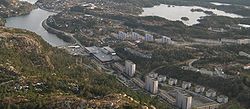Laksevåg bydel | |
|---|---|
 Central Loddefjord | |
 Map of the 8 boroughs of Bergen | |
| Coordinates: 60°22′23″N 05°14′24″E / 60.37306°N 5.24000°E | |
| Country | Norway |
| Region | Western Norway |
| County | Vestland |
| District | Midhordland |
| City | Bergen |
| Area | |
| • Total | 29.96 km2 (11.57 sq mi) |
| • Rank | 5th |
| 6.7% of total | |
| Population (2014) | |
| • Total | 39,584 |
| • Rank | 5th |
| • Density | 1,300/km2 (3,400/sq mi) |
| 14.6% of total | |
| Time zone | UTC+01:00 (CET) |
| • Summer (DST) | UTC+02:00 (CEST) |
| ISO 3166 code | NO-120105 |
Laksevåg is a borough of the city of Bergen in Vestland county, Norway. The borough is located in the western part of the municipality. Historically, the area was called Laxevaag, and it was a separate municipality until 1972 when it was merged into Bergen.[1]
The borough of Laksevåg has residential areas on the hillside of the mountain Damsgårdsfjellet facing the Puddefjorden. By the fjord itself are several industrial buildings, many of them connected with the maritime industry. The rococo-style Damsgård Manor is located in the borough.
Like the neighboring borough of Fyllingsdalen, many of the neighborhoods of Laksevåg consist of apartment buildings, especially in the area around the main service centre, the Vestkanten shopping centre. The main road to Sotra passes through the Loddefjord area in western Laksevåg.
History[edit]
The municipality of Laksevåg was established on 1 July 1918 when it was separated from the municipality of Askøy. On 1 January 1972, the municipalities surrounding the city of Bergen were merged with the city to form a large new municipality of Bergen. The municipalities involved in the merger were Arna, Fana, Laksevåg and Åsane.[2]
Since the merger, the area is now the borough of the city of Bergen, with very similar borders to those of the old municipality. After it was merged with Bergen, the former municipality was split into two boroughs: Laksevåg, which consisted of neighborhoods south of Puddefjorden separating it from the city centre, and Loddefjord, consisting of neighborhoods further west, closer to the islands of Sotra. In 2000, the boroughs were merged forming the borough of Laksevåg.
Geography[edit]
The mountain Gravdalsfjellet peaks at 351 metres (1,152 ft) in elevation.[3]
Villages and neighborhoods[edit]
The borough of Laksevåg includes the villages and neighborhoods: Alvøen, Bjørndal, Drotningsvik, Godvik, Gravdal, Hetlevik, Håkonshella, Kjøkkelvik, Loddefjord, Loddefjorddalen, Mathopen, Olsvik, and Vadmyra.
Local attractions[edit]
- Alvøen Mansion (Alvøen Hovedbygning) – Historic building constructed in the 1790s, reconstruction in 1830. opened as a museum in 1983[4]
- Damsgård Manor – Historic manor house and estate[5]
- Gravdal Manor (Gravdal hovedgård) – Historic Gravdal manor house, later military command headquarters [6]
- Kvarven Fort – Coastal defense built to protect the local port and naval installations[7]
- Lyderhorn – One of the seven mountains surrounding Bergen
- Damsgård Mountain (Damsgårdsfjellet) – One of the seven mountains surrounding Bergen
Gallery[edit]
-
Alvøen Mansion
-
Damsgård Manor
-
Gravdal Manor
-
Kvarven Fort
-
Lyderhorn
References[edit]
Footnotes[edit]
- ^ Store norske leksikon. "Laksevåg – bydel i Bergen" (in Norwegian). Retrieved 24 October 2014.
- ^ "Laksevåg før og nå" (in Norwegian). Bergen kommune. Archived from the original on 23 February 2013.
- ^ Viggohytten har brent ned til grunnen
- ^ Alvøen hovedbygning (bymuseet i bergen museene)
- ^ Damsgård Manor (bymuseet i bergen museene)
- ^ Mølledrift og annen virksomhet i Gravdal (Ole Kristian Jørgensen) Archived 2012-10-12 at the Wayback Machine
- ^ Kvarven fort (Mediesenteret ved Høgskolen i Bergen)
Bibliography[edit]
- Fossen, Kjell (1984–1991). Laksevågs historie. Bergen. ISBN 8271280783.
{{cite book}}: CS1 maint: location missing publisher (link) - Frichsen, Sigurd (2000). Sånn va' det. Folket, kirken og fergen. Laksevåg. ISBN 8299559308.
{{cite book}}: CS1 maint: location missing publisher (link) - Frichsen, Sigurd (2001). Laksevåg forteller. Sånn va' det II. Laksevåg. ISBN 8299559316.
{{cite book}}: CS1 maint: location missing publisher (link) - Hellesund, Kristian (2002). Årbok for Laksevåg 2002. Olsvik. ISBN 8299653002.
- Lyngvi, Arne (2000). Bomber over Laksevåg : 4. oktober 1944 og tiden som fulgte. Bergen. ISBN 8279160086.
{{cite book}}: CS1 maint: location missing publisher (link)







Well, that’s interesting to know that Psilotum nudum are known as whisk ferns. Psilotum nudum is the commoner species of the two. While the P. flaccidum is a rare species and is found in the tropical islands. Both the species are usually epiphytic in habit and grow upon tree ferns. These species may also be terrestrial and grow in humus or in the crevices of the rocks.
View the detailed Guide of Psilotum nudum: Detailed Study Of Psilotum Nudum (Whisk Fern), Classification, Anatomy, Reproduction